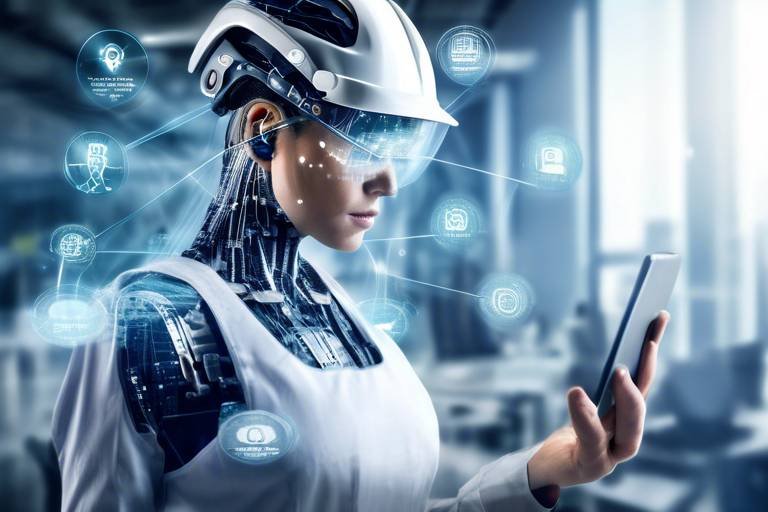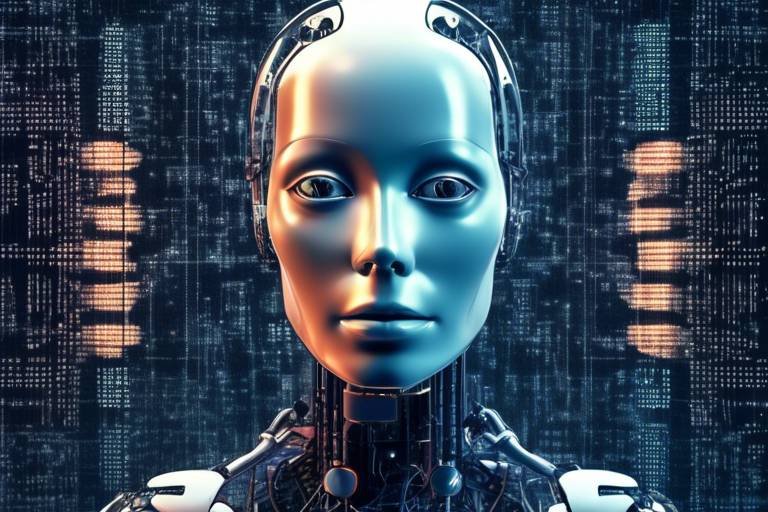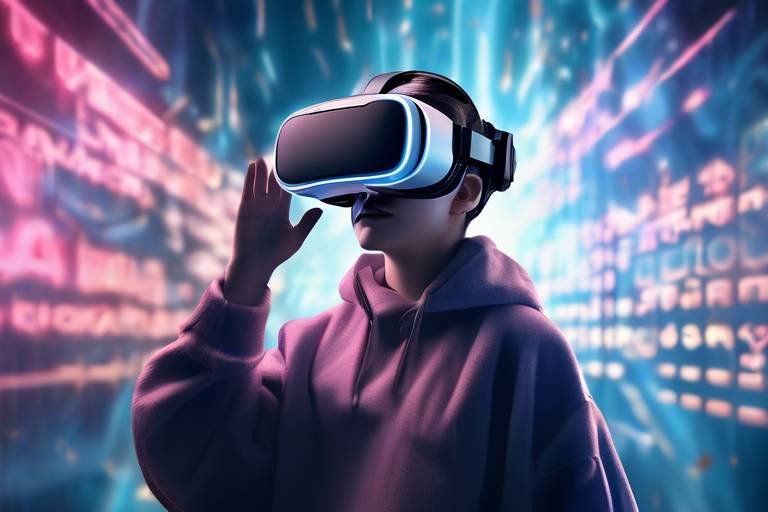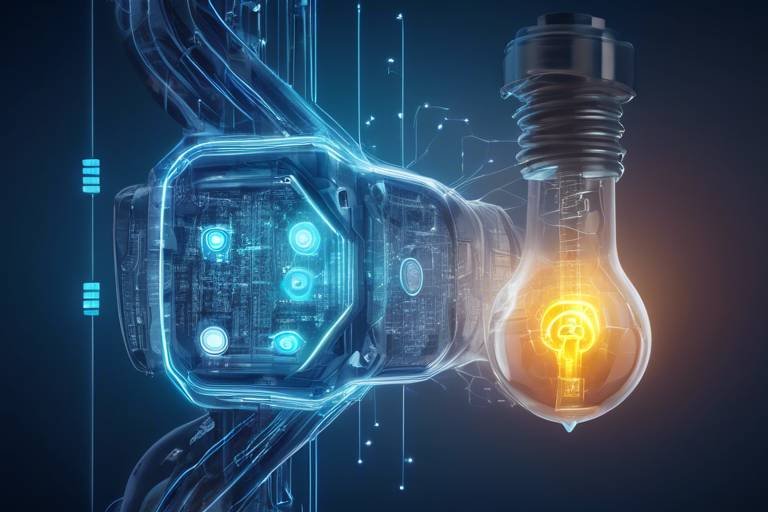Role of AI in the Evolution of the Internet of Things (IoT)
The integration of artificial intelligence (AI) with the Internet of Things (IoT) is nothing short of revolutionary. Imagine a world where your coffee machine knows exactly when you wake up, or your car can predict the best route based on real-time traffic data. This is not just a fantasy; it's the reality that AI and IoT are creating together. As these technologies evolve, they enhance connectivity, improve data processing, and automate processes across various industries, leading to smarter and more efficient systems. The synergy between AI and IoT is paving the way for innovations that promise to change the way we live and work.
At its core, the role of AI in IoT is about making devices smarter. Traditional IoT devices collect data and perform predefined tasks, but with AI, these devices can learn from the data they gather. They can adapt their behaviors based on past experiences and even predict future outcomes. This evolution is not just about adding intelligence; it’s about enhancing the overall user experience and operational efficiency. For instance, in smart homes, AI can analyze patterns in energy usage and optimize heating or cooling systems, leading to significant energy savings.
As we delve deeper into this topic, it's essential to understand the fundamental concepts of both AI and IoT. AI refers to the simulation of human intelligence processes by machines, particularly computer systems. This includes learning, reasoning, and self-correction. On the other hand, IoT is a network of interconnected devices that communicate and exchange data with each other. When combined, these two technologies create a powerful ecosystem where devices not only connect but also learn and evolve, leading to applications that were previously unimaginable.
The impact of AI on IoT is profound. It enhances the ability of devices to process vast amounts of data in real-time, enabling decision-making that is faster and more informed. For example, consider a manufacturing plant equipped with IoT sensors that monitor machinery performance. With AI, these sensors can analyze data trends, predict when a machine is likely to fail, and alert maintenance teams before any downtime occurs. This predictive maintenance not only saves costs but also improves safety and efficiency.
In conclusion, the role of AI in the evolution of IoT is a game-changer. It transforms ordinary devices into intelligent systems capable of learning and adapting to their environments. As we continue to explore the integration of these technologies, we will uncover even more innovative applications that will enhance our daily lives and revolutionize industries.
- What is the Internet of Things (IoT)?
The Internet of Things (IoT) refers to the network of physical devices connected to the internet, capable of collecting and exchanging data. - How does AI enhance IoT?
AI enhances IoT by enabling devices to learn from data, make predictions, and automate processes, leading to smarter and more efficient operations. - What are some applications of AI in IoT?
Applications include smart home devices, industrial automation, predictive maintenance, and personalized user experiences. - What challenges does AI and IoT integration face?
Challenges include data security, privacy concerns, and the need for robust infrastructure to support these advanced technologies.

Understanding AI and IoT Integration
In today's fast-paced digital landscape, the integration of Artificial Intelligence (AI) and the Internet of Things (IoT) is revolutionizing how we interact with technology. Imagine a world where your refrigerator can not only keep your food fresh but also suggest recipes based on what you have inside. That's the magic of AI and IoT working together. By combining the analytical prowess of AI with the connectivity of IoT, we create systems that can learn, adapt, and improve over time, leading to smarter devices that enhance our daily lives.
At its core, IoT refers to the network of physical devices—ranging from household appliances to industrial machines—that are connected to the internet and can collect and exchange data. On the other hand, AI encompasses a variety of technologies that enable machines to simulate human intelligence, including machine learning, natural language processing, and computer vision. When these two domains converge, they enable devices to not only gather data but also to analyze it in real-time, providing insights that were previously unimaginable.
Consider this: an IoT-enabled smart thermostat can monitor your home's temperature and adjust it based on your preferences. But when AI is integrated, it can learn from your habits—like when you typically leave for work or come home—and optimize energy usage accordingly. This results in not just comfort but also significant savings on energy bills. The integration of AI and IoT creates a feedback loop where devices continuously improve their performance based on the data they collect and analyze.
Furthermore, the potential applications of this integration are vast and varied. From smart cities that optimize traffic flow to healthcare systems that monitor patient vitals in real-time, the fusion of AI and IoT is paving the way for a more interconnected and efficient world. In industrial settings, for instance, machinery equipped with sensors can predict failures before they happen, reducing downtime and maintenance costs. This predictive capability is a game-changer, transforming how industries operate and maintain their equipment.
However, while the benefits are substantial, it is essential to recognize the challenges that come with this integration. As devices become smarter, they also become more complex, leading to potential issues regarding data security and privacy. With an increasing number of devices connected to the internet, the attack surface for malicious activities expands, making it crucial for developers to implement robust security measures. Additionally, ethical considerations surrounding data usage must be addressed to ensure that users' privacy is respected.
In summary, the integration of AI and IoT is not just a technological advancement; it's a significant leap towards creating a more efficient, responsive, and intelligent world. As we move forward, understanding and navigating the complexities of this integration will be essential for harnessing its full potential.

Enhanced Data Processing Capabilities
In the world of the Internet of Things (IoT), the ability to process data efficiently is not just a luxury; it's a necessity. With the integration of artificial intelligence (AI), IoT devices are not only collecting data but also transforming it into actionable insights almost instantaneously. Imagine a world where your smart thermostat learns your preferences and adjusts the temperature before you even walk through the door. This is the power of enhanced data processing capabilities fueled by AI.
AI significantly boosts the data processing capabilities of IoT devices, enabling real-time analytics and decision-making that enhance operational efficiency and responsiveness across various applications. The combination of AI and IoT allows for a more dynamic interaction between devices and users, creating a seamless experience. For instance, in smart cities, traffic lights can adapt to real-time traffic conditions, reducing congestion and improving overall flow. This is achieved through the continuous data analysis provided by AI algorithms that process information from various sources.
To truly understand how AI enhances data processing in IoT, it’s essential to explore the various data collection techniques employed by these devices. IoT devices gather data through numerous methods, including:
- Sensor technologies that monitor environmental conditions.
- Wearable devices that track health metrics.
- Smart appliances that report usage patterns.
Each of these methods contributes to a wealth of data that AI can analyze. However, the effectiveness of AI relies heavily on the quality and accuracy of the data collected. If the data is flawed or incomplete, the insights generated can lead to poor decision-making. Therefore, ensuring accurate data gathering is vital for effective AI implementation and analysis.
When discussing data collection, we can't overlook the importance of sensor technologies. These sensors are at the heart of IoT devices, capturing critical data that AI algorithms will later process. For example, temperature sensors in a smart home can monitor the environment and relay that information to an AI system that adjusts heating or cooling automatically based on user preferences. This not only enhances comfort but also optimizes energy consumption, leading to cost savings.
Different types of sensors play unique roles in the IoT ecosystem. Here are some common sensor technologies:
- Temperature Sensors: Monitor heat levels and adjust systems accordingly.
- Motion Sensors: Detect movement to enhance security or automate lighting.
- Humidity Sensors: Help in maintaining optimal conditions in various environments.
These sensors feed data into AI systems, which then analyze the information to make predictions or trigger actions. For instance, a humidity sensor in a smart greenhouse can inform the irrigation system when to water plants, ensuring they receive the right amount of moisture without waste.
Data transmission is another crucial aspect of IoT that enhances processing capabilities. Various methods, including protocols like MQTT and CoAP, facilitate seamless communication between devices and AI systems. These protocols ensure that data is transmitted quickly and efficiently, allowing AI to process information in real-time. The faster the data transmission, the quicker the insights, leading to timely decisions that can significantly impact operations.
In conclusion, the enhanced data processing capabilities brought about by AI in IoT systems are revolutionizing how we interact with technology. By leveraging real-time analytics, accurate data collection, and efficient transmission methods, industries can achieve unprecedented levels of efficiency and responsiveness. As we continue to explore the integration of AI and IoT, the possibilities seem limitless, paving the way for smarter, more efficient systems that can adapt and learn over time.
1. How does AI improve data processing in IoT devices?
AI enhances data processing by enabling real-time analytics and decision-making, allowing IoT devices to learn from data and adapt their functions accordingly.
2. What are some common data collection techniques used in IoT?
Common data collection techniques include the use of sensors, wearable devices, and smart appliances that gather data on various metrics such as temperature, movement, and usage patterns.
3. Why is accurate data gathering important for AI in IoT?
Accurate data gathering is crucial because flawed or incomplete data can lead to poor decision-making and ineffective AI implementations.
4. What role do sensor technologies play in IoT?
Sensor technologies are essential as they capture critical data that AI algorithms process to automate systems and improve efficiency.
5. What are some data transmission methods in IoT?
Data transmission methods include protocols such as MQTT and CoAP, which facilitate quick and efficient communication between IoT devices and AI systems.

Data Collection Techniques
In the rapidly evolving landscape of IoT, the methods by which data is collected are pivotal to the effectiveness of AI applications. Imagine a bustling city where every streetlight, vehicle, and building is interconnected, sharing vital information in real-time. This is the essence of IoT, where data collection techniques play a crucial role in ensuring that the AI systems can learn and adapt efficiently. The integration of various data collection techniques allows IoT devices to gather accurate and relevant information, which is essential for effective analysis and decision-making.
One of the primary methods of data collection is through sensor technologies. Sensors are like the senses of IoT devices, capturing everything from temperature and humidity to motion and light levels. These sensors are embedded in various devices, such as smart thermostats, wearable health monitors, and even industrial machinery. For instance, a smart thermostat uses temperature sensors to collect data about the environment, enabling it to learn user preferences and optimize energy consumption. This not only enhances comfort but also contributes to energy efficiency.
Another critical aspect of data collection involves data transmission methods. Once data is collected, it must be transmitted to a central system or cloud for processing. This is where various communication protocols come into play. Common methods include:
- Wi-Fi: Allows devices to connect to the internet and transmit data over large distances.
- Bluetooth: Ideal for short-range communication, often used in wearable devices.
- LoRaWAN: A low-power, wide-area network protocol suitable for long-range communication, often utilized in smart agriculture.
These transmission methods ensure that the data collected by sensors is relayed efficiently, allowing AI algorithms to analyze and derive insights. The seamless flow of data is crucial; after all, what good is a sensor if the information it gathers doesn't reach the AI system in time? This real-time data transmission enables immediate responses, making IoT systems more responsive and adaptable.
However, the effectiveness of these data collection techniques hinges on the accuracy of the data gathered. Poor-quality data can lead to misleading insights, which is why implementing robust data validation processes is essential. For instance, using multiple sensors to cross-verify data can enhance reliability. Moreover, regular calibration of sensors ensures that they remain accurate over time, much like how a musician tunes their instrument before a concert to ensure the best performance.
In summary, the integration of advanced data collection techniques is fundamental to the success of AI in IoT. By leveraging sensor technologies and efficient data transmission methods, IoT devices can gather and relay critical information that empowers AI systems to learn, adapt, and ultimately enhance our everyday lives. As we continue to innovate and refine these techniques, the potential for smarter, more efficient systems is boundless.
- What are the main types of sensors used in IoT? There are various types of sensors, including temperature, humidity, motion, and pressure sensors, each designed to capture specific data relevant to their applications.
- How does data transmission affect IoT performance? Efficient data transmission ensures that information is relayed in real-time, enabling immediate responses and enhancing the overall effectiveness of IoT systems.
- Why is data accuracy important in AI and IoT? Accurate data is crucial for reliable insights; poor-quality data can lead to incorrect conclusions and ineffective AI applications.

Sensor Technologies
When we talk about the backbone of the Internet of Things (IoT), we can't overlook the pivotal role of . These tiny yet powerful devices are the eyes and ears of IoT systems, capturing vital data from the environment and feeding it into artificial intelligence (AI) algorithms for processing. Imagine a smart thermostat that detects temperature changes in your home; it’s the sensor at work, tirelessly monitoring conditions to optimize your comfort while conserving energy. Without these sensors, the world of IoT would be akin to a ship without a compass—lost and directionless.
Sensors come in various forms and functionalities, each tailored to specific applications. For instance, temperature sensors are essential in climate control systems, while motion sensors play a crucial role in security systems. The diversity of sensor technologies is what makes IoT applications so versatile. Here are some key types of sensors commonly used in IoT:
- Temperature Sensors: Monitor ambient temperature for HVAC systems, agriculture, and food storage.
- Proximity Sensors: Detect the presence of objects within a certain range, useful in smart parking systems.
- Light Sensors: Adjust lighting based on natural light availability, enhancing energy efficiency in smart homes.
- Pressure Sensors: Used in various industrial applications to monitor pressure levels in machinery and pipelines.
- Humidity Sensors: Essential for weather stations and indoor climate control, ensuring optimal conditions.
The data collected by these sensors is not just raw information; it’s a treasure trove of insights that can lead to better decision-making. However, the effectiveness of AI in interpreting this data relies heavily on the accuracy and reliability of the sensors themselves. Thus, selecting the right sensor technology is crucial. For example, in a smart agriculture setup, using soil moisture sensors can help farmers optimize irrigation, leading to significant water savings and improved crop yields. This not only boosts productivity but also promotes sustainable practices.
Moreover, advancements in sensor technologies are continually enhancing IoT capabilities. With the advent of IoT-enabled sensors, devices can now communicate over the internet, enabling real-time monitoring and control. This connectivity allows for data analytics that can predict trends and provide actionable insights. For example, smart cities utilize a network of sensors to manage traffic flow, monitor air quality, and enhance public safety, showcasing how sensor technologies can transform urban living.
In conclusion, sensor technologies are not just components of IoT systems; they are the very foundation upon which intelligent, automated solutions are built. As we advance further into the digital age, the importance of these sensors will only grow, paving the way for more innovative applications that enhance our daily lives and industries alike.

Data Transmission Methods
When it comes to the Internet of Things (IoT), the methods of data transmission are crucial for ensuring that devices communicate effectively and efficiently. Imagine a bustling city where every vehicle, pedestrian, and traffic light needs to exchange information seamlessly to keep everything running smoothly. This is akin to how IoT devices rely on various data transmission methods to relay information to and from artificial intelligence systems. The choice of transmission method can significantly impact the performance, reliability, and scalability of IoT applications.
There are several popular data transmission methods employed in IoT systems, each with its unique advantages and challenges. Let's explore some of the most common methods:
- Wi-Fi: This widely used technology provides high-speed internet access and is perfect for devices that require significant bandwidth. However, its range can be limited, and it may not be ideal for devices spread across large areas.
- Bluetooth: Known for its low energy consumption, Bluetooth is perfect for short-range communication between devices. It's commonly used in wearables and smart home devices, but its range is limited compared to Wi-Fi.
- Cellular Networks: Utilizing existing mobile networks, cellular transmission allows IoT devices to communicate over long distances. This is particularly useful for devices that need to operate in remote areas, though it often comes with higher data costs.
- LoRaWAN (Long Range Wide Area Network): This technology is designed for long-range, low-power communication. It’s ideal for applications like smart agriculture and environmental monitoring, where devices need to transmit small amounts of data over large distances.
- Zigbee: A low-power, low-data-rate wireless technology, Zigbee is often used in home automation systems. Its mesh networking capability allows devices to communicate with each other even if they are not within direct range.
Each of these methods plays a vital role in the interconnected world of IoT. The selection of a transmission method depends on various factors such as range, data requirements, energy consumption, and the specific application needs. For instance, while Wi-Fi may be suitable for smart home devices that require high bandwidth, LoRaWAN could be the better choice for agricultural sensors that need to transmit small data packets over long distances.
Moreover, the integration of these transmission methods with AI algorithms enhances the overall functionality of IoT systems. With AI's ability to analyze data in real-time, the efficiency of data transmission can be optimized, ensuring that the right information gets to the right place at the right time. This synergy between AI and IoT not only improves operational efficiency but also enables predictive analytics and smarter decision-making processes.
As we continue to explore the evolution of IoT, understanding the importance of data transmission methods becomes increasingly vital. These methods form the backbone of communication in IoT, allowing devices to share insights and collaborate for a more connected and intelligent world.
1. What is the most common data transmission method used in IoT?
The most common data transmission methods in IoT include Wi-Fi, Bluetooth, cellular networks, and LoRaWAN. The choice depends on the specific application requirements.
2. How does AI enhance data transmission in IoT?
AI enhances data transmission by optimizing the flow of information, ensuring that data is processed in real-time and improving decision-making capabilities.
3. What are the challenges associated with data transmission in IoT?
Challenges include limited range, data security, energy consumption, and potential interference from other devices or networks.
4. Can multiple data transmission methods be used simultaneously in IoT?
Yes, many IoT systems utilize multiple data transmission methods to take advantage of the strengths of each, ensuring robust communication across various environments.

Machine Learning Applications in IoT
When we talk about the intersection of Machine Learning (ML) and the Internet of Things (IoT), we're diving into a realm where devices not only communicate but also learn and adapt. Imagine a world where your home thermostat not only adjusts the temperature based on your preferences but also predicts your comfort needs by analyzing your daily routines. This is just one of the many ways ML is revolutionizing IoT applications.
One of the most exciting applications of ML in IoT is in predictive maintenance. In industries such as manufacturing and transportation, machines are equipped with sensors that collect vast amounts of data. Machine learning algorithms analyze this data to predict when a machine is likely to fail, allowing for maintenance to be performed just in time, thus minimizing downtime and saving costs. For example, a factory might use ML to monitor the vibration of machinery, alerting technicians before a breakdown occurs.
Another fascinating application is in anomaly detection. IoT devices continuously gather data, and ML algorithms can sift through this information to identify patterns. When something deviates from the norm—like a sudden spike in energy consumption in a smart grid—these algorithms can alert operators to potential issues, such as equipment malfunctions or cyber threats. This not only enhances operational efficiency but also bolsters security measures.
Moreover, ML plays a crucial role in creating personalized user experiences. Consider smart home devices that learn from user behaviors. For instance, a smart speaker can analyze your music preferences over time and suggest playlists that suit your mood. Similarly, smart refrigerators can track your grocery purchases and suggest recipes based on what you have available. This level of personalization transforms mundane tasks into seamless, enjoyable experiences.
To illustrate the impact of ML in IoT, let's look at a few key applications:
| Application | Description | Benefits |
|---|---|---|
| Predictive Maintenance | Using sensor data to anticipate equipment failures. | Reduces downtime, lowers maintenance costs. |
| Anomaly Detection | Identifying unusual patterns in data for security and operational efficiency. | Enhances security, prevents equipment failures. |
| Personalized User Experience | Tailoring services and suggestions based on user behavior. | Improves user satisfaction, increases engagement. |
As we can see, the integration of ML with IoT is not just a trend; it's a transformation that enhances the way we interact with technology. The ability of these systems to learn and adapt is paving the way for smarter cities, more efficient industries, and ultimately, a more connected world. However, with great power comes great responsibility. As we embrace these advancements, we must also consider the ethical implications and ensure that data privacy and security are prioritized.
- What is the role of machine learning in IoT? Machine learning enhances IoT by enabling devices to learn from data, predict outcomes, and make decisions autonomously.
- How does predictive maintenance work? Predictive maintenance uses data from IoT sensors to predict when equipment will fail, allowing for timely maintenance to be performed.
- What are the benefits of anomaly detection in IoT? Anomaly detection helps identify unusual patterns that may indicate security threats or equipment malfunctions, enhancing overall safety and efficiency.

Improving Automation Through AI
In today's fast-paced world, the integration of artificial intelligence (AI) with the Internet of Things (IoT) is revolutionizing how industries operate. By harnessing the power of AI, businesses are not just enhancing efficiency; they're also paving the way for a future where automation becomes the norm. Imagine walking into a factory where machines communicate with each other, making real-time decisions without human intervention. This is not science fiction; it's the reality of AI-driven automation in IoT systems.
One of the most significant impacts of AI in automation is seen in sectors like manufacturing, healthcare, and smart homes. In manufacturing, AI algorithms analyze data from various sensors embedded in machines to predict when maintenance is needed, thereby preventing costly downtimes. This predictive maintenance is a game-changer, allowing companies to save both time and money while ensuring optimal operation. With AI, machines can learn from past performance, adapt to changing conditions, and ultimately enhance productivity.
In healthcare, AI-driven IoT devices are transforming patient care. Wearable devices continuously monitor vital signs and send alerts to healthcare providers if anomalies are detected. This proactive approach not only improves patient outcomes but also reduces the workload on medical staff. Can you imagine a world where your health is monitored in real-time, and potential issues are flagged before they escalate? That’s the beauty of AI in healthcare automation.
The smart home revolution is another fascinating area where AI and IoT converge to improve automation. Devices like smart thermostats, lighting systems, and security cameras work together to create a seamless living experience. For instance, a smart thermostat learns your daily routine and adjusts the temperature accordingly, optimizing energy usage while ensuring comfort. This level of automation not only enhances convenience but also contributes to energy efficiency, which is crucial in today's environmentally conscious society.
However, implementing AI in automation does come with its challenges. Companies must invest in robust infrastructure to support these advanced technologies. Moreover, the integration process can be complex, requiring a deep understanding of both AI and IoT systems. Despite these hurdles, the potential benefits far outweigh the challenges. As industries continue to embrace AI-driven automation, we can expect to see significant improvements in operational efficiency, safety, and overall productivity.
To summarize, the role of AI in improving automation through IoT is profound. From predictive maintenance in manufacturing to real-time health monitoring and smart home conveniences, the applications are vast and varied. As we continue to explore this exciting intersection of technology, it’s clear that the future is not only automated but also smarter, more efficient, and ultimately more human-centric.
- What is the primary benefit of integrating AI with IoT?
The primary benefit is enhanced automation, leading to improved efficiency, reduced costs, and better decision-making capabilities across various industries.
- How does AI improve predictive maintenance in manufacturing?
AI analyzes data collected from machines to predict when maintenance should be performed, minimizing downtime and optimizing production processes.
- Can AI in smart homes really save energy?
Yes, smart devices learn user habits and optimize energy usage accordingly, leading to significant savings on utility bills.
- What challenges do companies face when implementing AI in IoT?
Challenges include the need for robust infrastructure, complexity in integration, and ensuring data security and privacy.

Smart Home Technologies
Smart home technologies are revolutionizing the way we live, making our homes not only more convenient but also significantly more efficient. Imagine walking into a room and having the lights turn on automatically, the thermostat adjust to your preferred temperature, and your favorite music start playing—all without lifting a finger. This is the magic of artificial intelligence (AI) combined with the Internet of Things (IoT). These technologies work together to create environments that learn from your habits and preferences, offering a level of customization that was once the stuff of science fiction.
At the heart of smart home technologies are devices that communicate with each other, sharing data and insights to enhance your living experience. For instance, smart thermostats not only allow you to control your home's temperature remotely but also learn your schedule over time. They can adjust settings automatically, ensuring your home is always at the perfect temperature when you arrive. This not only provides comfort but also saves on energy costs, making it a win-win situation.
Moreover, smart home systems can integrate with voice-activated assistants like Amazon's Alexa or Google Assistant, allowing for hands-free control of your devices. You can simply say, "Turn off the lights," and watch as your home responds instantly. This level of automation not only enhances user convenience but also promotes energy efficiency, as you can easily manage your energy consumption with simple voice commands.
However, the real beauty of smart home technologies lies in their ability to work together. For example, your smart security system can communicate with your smart locks and cameras. If a security breach is detected, your locks can automatically engage, and you can receive real-time alerts on your smartphone. This interconnectedness ensures that your home is not just smart but also safe.
While the benefits are numerous, it's essential to consider the potential challenges as well. Issues such as data security and privacy must be addressed to ensure that your smart home remains a sanctuary rather than a target for cyber threats. Nonetheless, as technology advances, so too do the safeguards that protect our homes and personal information.
In conclusion, smart home technologies powered by AI and IoT are not just about convenience—they're about creating a home environment that adapts to your lifestyle. As these technologies continue to evolve, we can expect even more innovative solutions that will make our lives easier, safer, and more efficient.
- What are smart home technologies?
Smart home technologies refer to devices and systems that enhance the functionality of a home through automation and connectivity, allowing for remote control and monitoring. - How do smart home devices communicate?
Smart home devices typically communicate through Wi-Fi, Bluetooth, or other wireless protocols, enabling them to share data and work together seamlessly. - Are smart homes safe?
While smart homes offer many benefits, they can also present security risks. It's crucial to implement strong passwords, use secure networks, and regularly update device firmware to protect against vulnerabilities.

Industrial Automation
In today's fast-paced world, powered by artificial intelligence (AI) is revolutionizing how industries operate. Imagine a factory where machines not only perform tasks but also learn and adapt to improve their efficiency over time. This is not science fiction; it's the reality of AI-driven IoT systems. By integrating AI with IoT, industries can achieve unprecedented levels of productivity, safety, and cost-effectiveness.
One of the most significant advantages of AI in industrial automation is its ability to optimize production processes. AI algorithms analyze vast amounts of data collected from various sensors and devices on the factory floor. This data can include everything from machine performance metrics to environmental conditions. By processing this information in real-time, AI can identify bottlenecks, predict maintenance needs, and even suggest adjustments to improve workflow. For instance, if a machine is showing signs of wear, the AI can alert operators before a breakdown occurs, allowing for timely maintenance and minimizing downtime.
Moreover, AI enhances safety in industrial settings. With the integration of smart sensors and AI analytics, companies can monitor hazardous conditions and take preventive measures. For example, if a worker enters a restricted area, AI can trigger alarms or automatically shut down machinery to prevent accidents. This not only protects employees but also reduces liability for companies. The ability to predict and mitigate risks is a game-changer in industries where safety is paramount.
Another aspect of industrial automation is the reduction of operational costs. By leveraging AI, companies can streamline their operations, reduce waste, and optimize resource allocation. For example, energy consumption can be monitored and adjusted automatically, ensuring that machines operate only when necessary. This not only saves money but also contributes to sustainability efforts, as industries strive to minimize their environmental impact.
While the benefits are clear, it's essential to recognize that implementing AI in industrial automation does come with challenges. Companies must invest in robust infrastructure to support these advanced technologies. This includes ensuring reliable connectivity between devices, as well as having the necessary cybersecurity measures in place to protect sensitive data. The transition to an AI-driven automated environment requires careful planning and execution, but the rewards are well worth the effort.
In conclusion, industrial automation fueled by AI is transforming the landscape of manufacturing and production. By enhancing efficiency, safety, and cost-effectiveness, AI-powered IoT systems are paving the way for smarter factories. As industries continue to embrace this technology, we can expect to see even more innovative solutions that will redefine the future of work.
- What is industrial automation?
Industrial automation refers to the use of control systems such as computers or robots for handling different processes and machinery in an industry to replace human intervention. - How does AI improve industrial automation?
AI improves industrial automation by enabling machines to learn from data, optimize processes, predict maintenance needs, and enhance safety measures. - What are the challenges of implementing AI in industrial automation?
Challenges include the need for robust infrastructure, cybersecurity concerns, and the necessity for significant investment in technology. - Can AI help reduce operational costs in industries?
Yes, AI can help reduce operational costs by optimizing resource allocation, minimizing waste, and improving energy efficiency.

Challenges in AI and IoT Implementation
Integrating artificial intelligence (AI) with the Internet of Things (IoT) is not without its hurdles. As we venture further into this exciting technological frontier, it's crucial to recognize the challenges that come along with it. While the benefits are immense, the path to successful implementation is often riddled with issues that can hinder progress. One of the most pressing challenges is data security. With millions of devices connected and exchanging information, the risk of cyberattacks escalates. IoT devices often lack robust security measures, making them attractive targets for hackers. This vulnerability can lead to unauthorized access to sensitive data, potentially resulting in severe consequences for both individuals and organizations.
Another significant concern is privacy issues. The sheer volume of data collected by IoT devices raises questions about how this information is used and who has access to it. For instance, smart home devices that monitor user behavior can inadvertently infringe on personal privacy. As consumers become more aware of these implications, there is a growing demand for transparency in how data is collected, stored, and utilized. This calls for a careful balance between innovation and ethical practices, ensuring that users feel secure in their data usage.
Furthermore, the need for a robust infrastructure cannot be overstated. Implementing AI in IoT requires a solid foundation of hardware and software capable of processing vast amounts of data in real-time. Many existing systems are not equipped to handle the increased load, leading to inefficiencies and potential system failures. This infrastructure challenge is compounded by the fact that not all organizations have the resources to invest in the necessary technology, creating a disparity in who can effectively leverage AI and IoT.
Additionally, the complexity of integrating AI with various IoT devices presents its own set of challenges. Different devices may use incompatible communication protocols, making it difficult to create a unified system. This fragmentation can lead to increased costs and extended timelines for deployment. Companies must navigate these technical hurdles while also considering the need for skilled personnel who understand both AI and IoT technologies.
In summary, while the integration of AI and IoT holds tremendous potential, it is essential to address the challenges associated with implementation. From ensuring data security and protecting user privacy to building a robust infrastructure and navigating technical complexities, organizations must take a proactive approach to overcome these hurdles. By doing so, they can unlock the full benefits of this powerful combination and pave the way for a smarter, more connected future.
- What are the main challenges in AI and IoT integration?
The main challenges include data security, privacy issues, the need for robust infrastructure, and technical complexities in integrating various devices.
- How can organizations ensure data security in IoT?
Organizations can implement strong encryption methods, regular software updates, and comprehensive security protocols to protect their IoT devices from cyber threats.
- What role does privacy play in AI and IoT?
Privacy is crucial as IoT devices collect vast amounts of personal data. Organizations must ensure transparent data usage policies and adhere to ethical practices to maintain user trust.
- Why is infrastructure important for AI and IoT?
A robust infrastructure is necessary to handle the large volumes of data generated by IoT devices and to support real-time processing required for effective AI applications.

Security Vulnerabilities
As the integration of artificial intelligence (AI) with the Internet of Things (IoT) continues to expand, so too do the security vulnerabilities that threaten these interconnected systems. Imagine a world where your refrigerator not only keeps your food fresh but also communicates with your grocery app to reorder items when you're running low. Sounds convenient, right? However, this convenience comes at a cost: the security of your personal data and home network. IoT devices often lack robust security measures, making them prime targets for cybercriminals.
One of the primary vulnerabilities arises from the sheer number of devices connected to the internet. Each new device is a potential entry point for attackers. For example, if a hacker gains access to a smart thermostat, they could manipulate temperature settings or even infiltrate more sensitive systems within your home. The interconnected nature of IoT means that once a single device is compromised, the entire network can be at risk.
Moreover, many IoT devices are manufactured with minimal security features, often using default passwords that users neglect to change. This negligence creates an easy pathway for attackers. To illustrate, a recent study found that over 70% of IoT devices are vulnerable to attacks due to weak password policies. This alarming statistic underscores the need for manufacturers to prioritize security in their designs and for users to be vigilant in securing their devices.
| Vulnerability Type | Description | Potential Impact |
|---|---|---|
| Weak Authentication | Devices using default or weak passwords. | Unauthorized access to devices and networks. |
| Insecure Communication | Lack of encryption in data transmission. | Data interception and manipulation. |
| Outdated Firmware | Failure to update software and security patches. | Exploitation of known vulnerabilities. |
Another critical aspect of IoT security vulnerabilities is insecure communication. Many devices transmit data without proper encryption, allowing hackers to intercept sensitive information. This can include personal data, such as your location or usage patterns, which can be exploited for malicious purposes. Ensuring that data is encrypted during transmission is essential to safeguarding user privacy and maintaining trust in IoT systems.
Lastly, the issue of outdated firmware cannot be overlooked. Manufacturers often release updates to patch vulnerabilities, but many users fail to install these updates regularly. This negligence leaves devices susceptible to exploitation. In fact, a significant number of attacks target devices with known vulnerabilities that could have been mitigated through timely updates. It's crucial for both manufacturers and users to take proactive steps in maintaining device security.
In conclusion, while the integration of AI and IoT presents exciting possibilities, it also brings with it a host of security vulnerabilities that must be addressed. By understanding these risks and taking appropriate measures, we can help ensure that our connected devices enhance our lives without compromising our security.
- What are the most common security vulnerabilities in IoT devices? Common vulnerabilities include weak authentication, insecure communication, and outdated firmware.
- How can I secure my IoT devices? Change default passwords, enable encryption, and regularly update firmware to protect your devices.
- What impact can a compromised IoT device have? A compromised device can lead to unauthorized access to personal data, manipulation of device settings, and exploitation of the entire network.

Privacy Issues
In the age of interconnected devices, where our homes, cars, and even wearable gadgets are constantly communicating, have become a pressing concern. As we embrace the convenience that AI-driven IoT systems offer, it's crucial to acknowledge the potential risks associated with data collection and usage. After all, with great power comes great responsibility, right? The very nature of IoT involves gathering vast amounts of data, often personal in nature, which raises questions about who has access to this information and how it is being used.
One of the primary challenges is the sheer volume of data being collected. IoT devices can track everything from our daily routines to our health metrics. This data, if not handled properly, can lead to serious privacy breaches. Imagine a scenario where a hacker gains access to your smart home system, potentially unlocking doors or disabling security features. The implications can be alarming. Thus, ensuring that data is collected and stored securely is paramount.
Moreover, many users are unaware of the extent of data collection by their devices. Often, the terms and conditions we agree to are lengthy and filled with legal jargon, making it difficult for the average person to understand what they are consenting to. This lack of transparency can lead to a feeling of helplessness among users, who may feel that their privacy is being compromised without their knowledge. To combat this, companies must prioritize clear communication about data practices, allowing users to make informed decisions.
Additionally, there are ethical considerations surrounding the use of personal data. The collection of sensitive information raises the question of consent. Are users truly giving informed consent when they use IoT devices? Furthermore, once data is collected, it can be shared with third parties, often without the user’s explicit consent. This can lead to targeted advertising and even manipulation based on user behavior, which many find unsettling.
To address these privacy concerns, it’s essential for stakeholders, including developers, manufacturers, and policymakers, to come together and establish robust frameworks. Here are some key points that should be considered:
- Data Minimization: Only collect data that is necessary for the functionality of the device.
- Encryption: Use encryption methods to protect data both in transit and at rest.
- User Control: Allow users to have control over their data, including options to delete or modify it.
- Regular Audits: Conduct regular audits to ensure compliance with privacy standards and regulations.
In conclusion, while the integration of AI and IoT brings about incredible advancements, it also poses significant privacy challenges that cannot be ignored. As consumers, we must remain vigilant and informed about how our data is being used. As technology continues to evolve, so too must our approaches to safeguarding privacy, ensuring that we can enjoy the benefits of smart technology without sacrificing our personal information.
Q1: What are the main privacy concerns with IoT devices?
A1: The main privacy concerns include data collection without informed consent, potential data breaches, and the sharing of personal information with third parties.
Q2: How can I protect my privacy when using IoT devices?
A2: Users can protect their privacy by reading privacy policies, using strong passwords, enabling two-factor authentication, and regularly updating their devices.
Q3: Are there regulations in place to protect my data?
A3: Yes, various regulations such as GDPR in Europe and CCPA in California provide guidelines on data protection and user privacy rights.
Frequently Asked Questions
- What is the role of AI in IoT?
AI plays a crucial role in the Internet of Things by enhancing the capabilities of connected devices. It allows these devices to process data intelligently, learn from it, and make decisions, leading to smarter and more efficient systems.
- How does AI improve data processing in IoT?
AI significantly boosts data processing capabilities in IoT by enabling real-time analytics. This means that IoT devices can analyze data as it comes in, allowing for quicker decision-making and improved operational efficiency across various applications.
- What are the main data collection techniques used by IoT devices?
IoT devices utilize various data collection techniques, including sensor technologies, which capture critical information, and data transmission methods that ensure seamless communication between devices and AI systems. Accurate data gathering is essential for effective AI implementation.
- Can you explain how machine learning is applied in IoT?
Machine learning is applied in IoT through algorithms that analyze data to enable predictive maintenance, anomaly detection, and personalized user experiences. This integration allows devices to adapt and improve their functionality based on user behavior and environmental changes.
- What are some challenges in integrating AI with IoT?
Integrating AI with IoT comes with challenges such as data security vulnerabilities, privacy issues, and the necessity for robust infrastructure. These challenges must be addressed to ensure effective and safe implementation of AI-driven IoT solutions.
- How can security vulnerabilities in IoT be mitigated?
To mitigate security vulnerabilities in IoT, it's essential to implement strong encryption methods, regular software updates, and secure communication channels. These measures help protect data and ensure that devices remain secure from potential threats.
- What privacy concerns arise from AI-driven IoT systems?
Privacy concerns in AI-driven IoT systems stem from extensive data collection and usage, which can lead to unauthorized access or misuse of personal information. It's crucial to establish ethical practices and regulations to safeguard user privacy.



















